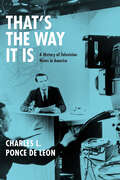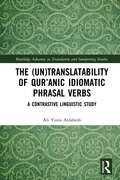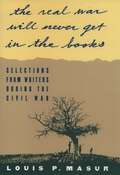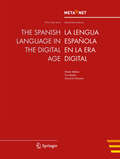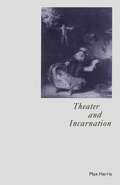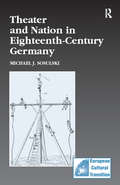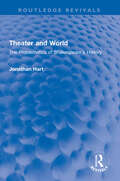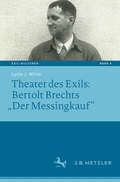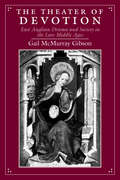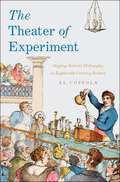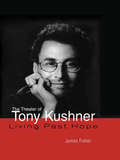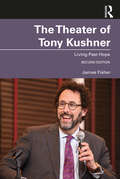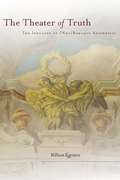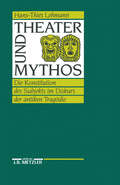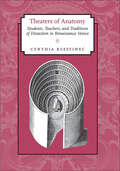- Table View
- List View
That's the Way It Is: A History of Television News in America
by Charles L. Ponce de LeonWhen critics decry the current state of our public discourse, one reliably easy target is television news. It’s too dumbed-down, they say; it’s no longer news but entertainment, celebrity-obsessed and vapid. The critics may be right. But, as Charles L. Ponce de Leon explains in That’s the Way It Is, TV news has always walked a fine line between hard news and fluff. The familiar story of decline fails to acknowledge real changes in the media and Americans’ news-consuming habits, while also harking back to a golden age that, on closer examination, is revealed to be not so golden after all. Ponce de Leon traces the entire history of televised news, from the household names of the late 1940s and early ’50s, like Eric Sevareid, Edward R. Murrow, and Walter Cronkite, through the rise of cable, the political power of Fox News, and the satirical punch of Colbert and Stewart. He shows us an industry forever in transition, where newsmagazines and celebrity profiles vie with political news and serious investigations. The need for ratings success—and the lighter, human interest stories that can help bring it—Ponce de Leon makes clear, has always sat uneasily alongside a real desire to report hard news. Highlighting the contradictions and paradoxes at the heart of TV news, and telling a story rich in familiar figures and fascinating anecdotes, That’s the Way It Is will be the definitive account of how television has showed us our history as it happens.
That's the Way It Is: A History of Television News in America
by Charles L. Ponce de LeonWhen critics decry the current state of our public discourse, one reliably easy target is television news. It’s too dumbed-down, they say; it’s no longer news but entertainment, celebrity-obsessed and vapid. The critics may be right. But, as Charles L. Ponce de Leon explains in That’s the Way It Is, TV news has always walked a fine line between hard news and fluff. The familiar story of decline fails to acknowledge real changes in the media and Americans’ news-consuming habits, while also harking back to a golden age that, on closer examination, is revealed to be not so golden after all. Ponce de Leon traces the entire history of televised news, from the household names of the late 1940s and early ’50s, like Eric Sevareid, Edward R. Murrow, and Walter Cronkite, through the rise of cable, the political power of Fox News, and the satirical punch of Colbert and Stewart. He shows us an industry forever in transition, where newsmagazines and celebrity profiles vie with political news and serious investigations. The need for ratings success—and the lighter, human interest stories that can help bring it—Ponce de Leon makes clear, has always sat uneasily alongside a real desire to report hard news. Highlighting the contradictions and paradoxes at the heart of TV news, and telling a story rich in familiar figures and fascinating anecdotes, That’s the Way It Is will be the definitive account of how television has showed us our history as it happens.
That's the Way It Is: A History of Television News in America
by Charles L. Ponce de LeonWhen critics decry the current state of our public discourse, one reliably easy target is television news. It’s too dumbed-down, they say; it’s no longer news but entertainment, celebrity-obsessed and vapid. The critics may be right. But, as Charles L. Ponce de Leon explains in That’s the Way It Is, TV news has always walked a fine line between hard news and fluff. The familiar story of decline fails to acknowledge real changes in the media and Americans’ news-consuming habits, while also harking back to a golden age that, on closer examination, is revealed to be not so golden after all. Ponce de Leon traces the entire history of televised news, from the household names of the late 1940s and early ’50s, like Eric Sevareid, Edward R. Murrow, and Walter Cronkite, through the rise of cable, the political power of Fox News, and the satirical punch of Colbert and Stewart. He shows us an industry forever in transition, where newsmagazines and celebrity profiles vie with political news and serious investigations. The need for ratings success—and the lighter, human interest stories that can help bring it—Ponce de Leon makes clear, has always sat uneasily alongside a real desire to report hard news. Highlighting the contradictions and paradoxes at the heart of TV news, and telling a story rich in familiar figures and fascinating anecdotes, That’s the Way It Is will be the definitive account of how television has showed us our history as it happens.
That's the Way It Is: A History of Television News in America
by Charles L. Ponce de LeonWhen critics decry the current state of our public discourse, one reliably easy target is television news. It’s too dumbed-down, they say; it’s no longer news but entertainment, celebrity-obsessed and vapid. The critics may be right. But, as Charles L. Ponce de Leon explains in That’s the Way It Is, TV news has always walked a fine line between hard news and fluff. The familiar story of decline fails to acknowledge real changes in the media and Americans’ news-consuming habits, while also harking back to a golden age that, on closer examination, is revealed to be not so golden after all. Ponce de Leon traces the entire history of televised news, from the household names of the late 1940s and early ’50s, like Eric Sevareid, Edward R. Murrow, and Walter Cronkite, through the rise of cable, the political power of Fox News, and the satirical punch of Colbert and Stewart. He shows us an industry forever in transition, where newsmagazines and celebrity profiles vie with political news and serious investigations. The need for ratings success—and the lighter, human interest stories that can help bring it—Ponce de Leon makes clear, has always sat uneasily alongside a real desire to report hard news. Highlighting the contradictions and paradoxes at the heart of TV news, and telling a story rich in familiar figures and fascinating anecdotes, That’s the Way It Is will be the definitive account of how television has showed us our history as it happens.
That's the Way It Is: A History of Television News in America
by Charles L. Ponce de LeonWhen critics decry the current state of our public discourse, one reliably easy target is television news. It’s too dumbed-down, they say; it’s no longer news but entertainment, celebrity-obsessed and vapid. The critics may be right. But, as Charles L. Ponce de Leon explains in That’s the Way It Is, TV news has always walked a fine line between hard news and fluff. The familiar story of decline fails to acknowledge real changes in the media and Americans’ news-consuming habits, while also harking back to a golden age that, on closer examination, is revealed to be not so golden after all. Ponce de Leon traces the entire history of televised news, from the household names of the late 1940s and early ’50s, like Eric Sevareid, Edward R. Murrow, and Walter Cronkite, through the rise of cable, the political power of Fox News, and the satirical punch of Colbert and Stewart. He shows us an industry forever in transition, where newsmagazines and celebrity profiles vie with political news and serious investigations. The need for ratings success—and the lighter, human interest stories that can help bring it—Ponce de Leon makes clear, has always sat uneasily alongside a real desire to report hard news. Highlighting the contradictions and paradoxes at the heart of TV news, and telling a story rich in familiar figures and fascinating anecdotes, That’s the Way It Is will be the definitive account of how television has showed us our history as it happens.
The: A Contrastive Linguistic Study (Routledge Advances in Translation and Interpreting Studies)
by Ali Yunis AldaheshQur’anic idiomaticity, in its all aspects, poses a great deal of challenge to Qur’an readers, learners, commentators, and translators. One of the most challenging aspects of Qur’anic idiomaticity is Qur’anic idiomatic phrasal verbs, where significances of proper Arabic verbs are entirely fused with significances of prepositions following them to produce new significances that have nothing to do with the basic significances of those verbs and prepositions. By examining a corpus of ten of the most influential English translations of the Qur’an, this study scrutinizes how some translators of the Qur’an have dealt with the phenomenon of Qur’anic idiomatic phrasal verbs, the difficulties that they have encountered when translating them into English, and the strategies that they have employed in their attempts to overcome the inherent ambiguity of such expressions and provide their functional-pragmatic equivalents for English readership. The study proposes a working model for analysing and assessing the translation of the Qur’anic idiomatic phrasal verbs and provides a number of theory-based recommendations for translators in general and Qur’an translators in particular.
The: A Contrastive Linguistic Study (Routledge Advances in Translation and Interpreting Studies)
by Ali Yunis AldaheshQur’anic idiomaticity, in its all aspects, poses a great deal of challenge to Qur’an readers, learners, commentators, and translators. One of the most challenging aspects of Qur’anic idiomaticity is Qur’anic idiomatic phrasal verbs, where significances of proper Arabic verbs are entirely fused with significances of prepositions following them to produce new significances that have nothing to do with the basic significances of those verbs and prepositions. By examining a corpus of ten of the most influential English translations of the Qur’an, this study scrutinizes how some translators of the Qur’an have dealt with the phenomenon of Qur’anic idiomatic phrasal verbs, the difficulties that they have encountered when translating them into English, and the strategies that they have employed in their attempts to overcome the inherent ambiguity of such expressions and provide their functional-pragmatic equivalents for English readership. The study proposes a working model for analysing and assessing the translation of the Qur’anic idiomatic phrasal verbs and provides a number of theory-based recommendations for translators in general and Qur’an translators in particular.
"...the real war will never get in the books": Selections from Writers During the Civil War
by Louis P. Masur"These thousands, and tens and twenties of thousands of American young men, badly wounded, all sorts of wounds, operated on, pallid with diarrhea, languishing, dying with fever, pneumonia, &c. open a new world somehow to me, giving closer insights, new things, exploring deeper mines than any yet, showing our humanity, (I sometimes put myself in fancy in the cot, with typhoid, or under the knife,) tried by terrible, fearfulest tests, probed deepest, the living soul's, the body's tragedies, bursting the petty bounds of art." So wrote Walt Whitman in March of 1863, in a letter telling friends in New York what he had witnessed in Washington's war hospitals. In this, we see both a description of war's ravages and a major artist's imaginative response to the horrors of war as it "bursts the petty bounds of art." In "...the real war will never get in the books", Louis Masur has brought together fourteen of the most eloquent and articulate writers of the Civil War period, including such major literary figures as Nathaniel Hawthorne, Harriet Beecher Stowe, Ralph Waldo Emerson, Frederick Douglass, Herman Melville, Walt Whitman, Henry Adams, and Louisa May Alcott. Drawing on a wide range of material, including diaries, letters, and essays, Masur captures the reactions of these writers as the war was waged, providing a broad spectrum of views. Emerson, for instance, sees the war "come as a frosty October, which shall restore intellectual & moral power to these languid & dissipated populations." African-American writer Charlotte Forten writes sadly of the slaughter at Fort Wagner: "It seems very, very hard that the best and noblest must be the earliest called away. Especially has it been so throughout this dreadful war." There are writings by soldiers in combat. John Esten Cooke, a writer of popular pre-Revolutionary romances serving as a Confederate soldier under J.E.B. Stuart, describes Stonewall Jackson's uniform: "It was positively scorched by sun--had that dingy hue, the product of sun and rain, and contact with the ground...but the men of the old Stonewall Brigade loved that coat." And John De Forest, a Union officer, describes facing a Confederate volley: "It was a long rattle like that which a boy makes in running with a stick along a picket-fence, only vastly louder; and at the same time the sharp, quiet whit-whit of bullets chippered close to our ears." And along the way, we sample many vivid portraits of the era, perhaps the most surprising of which is Louisa May Alcott's explanation of why she preferred her noon-to-midnight schedule in a Washington hospital: "I like it as it leaves me time for a morning run which is what I need to keep well....I trot up & down the streets in all directions, some times to the Heights, then half way to Washington, again to the hill over which the long trains of army wagons are constantly vanishing & ambulances appearing. That way the fighting lies, & I long to follow." With unmatched intimacy and immediacy, "...the real war will never get in the books" illuminates the often painful intellectual and emotional efforts of fourteen accomplished writers as they come to grips with "The American Apocalypse."
"...the real war will never get in the books": Selections from Writers During the Civil War
"These thousands, and tens and twenties of thousands of American young men, badly wounded, all sorts of wounds, operated on, pallid with diarrhea, languishing, dying with fever, pneumonia, &c. open a new world somehow to me, giving closer insights, new things, exploring deeper mines than any yet, showing our humanity, (I sometimes put myself in fancy in the cot, with typhoid, or under the knife,) tried by terrible, fearfulest tests, probed deepest, the living soul's, the body's tragedies, bursting the petty bounds of art." So wrote Walt Whitman in March of 1863, in a letter telling friends in New York what he had witnessed in Washington's war hospitals. In this, we see both a description of war's ravages and a major artist's imaginative response to the horrors of war as it "bursts the petty bounds of art." In "...the real war will never get in the books", Louis Masur has brought together fourteen of the most eloquent and articulate writers of the Civil War period, including such major literary figures as Nathaniel Hawthorne, Harriet Beecher Stowe, Ralph Waldo Emerson, Frederick Douglass, Herman Melville, Walt Whitman, Henry Adams, and Louisa May Alcott. Drawing on a wide range of material, including diaries, letters, and essays, Masur captures the reactions of these writers as the war was waged, providing a broad spectrum of views. Emerson, for instance, sees the war "come as a frosty October, which shall restore intellectual & moral power to these languid & dissipated populations." African-American writer Charlotte Forten writes sadly of the slaughter at Fort Wagner: "It seems very, very hard that the best and noblest must be the earliest called away. Especially has it been so throughout this dreadful war." There are writings by soldiers in combat. John Esten Cooke, a writer of popular pre-Revolutionary romances serving as a Confederate soldier under J.E.B. Stuart, describes Stonewall Jackson's uniform: "It was positively scorched by sun--had that dingy hue, the product of sun and rain, and contact with the ground...but the men of the old Stonewall Brigade loved that coat." And John De Forest, a Union officer, describes facing a Confederate volley: "It was a long rattle like that which a boy makes in running with a stick along a picket-fence, only vastly louder; and at the same time the sharp, quiet whit-whit of bullets chippered close to our ears." And along the way, we sample many vivid portraits of the era, perhaps the most surprising of which is Louisa May Alcott's explanation of why she preferred her noon-to-midnight schedule in a Washington hospital: "I like it as it leaves me time for a morning run which is what I need to keep well....I trot up & down the streets in all directions, some times to the Heights, then half way to Washington, again to the hill over which the long trains of army wagons are constantly vanishing & ambulances appearing. That way the fighting lies, & I long to follow." With unmatched intimacy and immediacy, "...the real war will never get in the books" illuminates the often painful intellectual and emotional efforts of fourteen accomplished writers as they come to grips with "The American Apocalypse."
The Spanish Language in the Digital Age (White Paper Series)
by Georg Rehm Hans UszkoreitThis white paper is part of a series that promotes knowledge about language technology and its potential. It addresses educators, journalists, politicians, language communities and others. The availability and use of language technology in Europe varies between languages. Consequently, the actions that are required to further support research and development of language technologies also differ for each language. The required actions depend on many factors, such as the complexity of a given language and the size of its community. META-NET, a Network of Excellence funded by the European Commission, has conducted an analysis of current language resources and technologies. This analysis focused on the 23 official European languages as well as other important national and regional languages in Europe. The results of this analysis suggest that there are many significant research gaps for each language. A more detailed expert analysis and assessment of the current situation will help maximise the impact of additional research and minimize any risks. META-NET consists of 54 research centres from 33 countries that are working with stakeholders from commercial businesses, government agencies, industry, research organisations, software companies, technology providers and European universities. Together, they are creating a common technology vision while developing a strategic research agenda that shows how language technology applications can address any research gaps by 2020.
Theater and Incarnation
by Max HarrisThis introduction to the theatre also attempts to offer a meditation on the theatricality of the Incarnation. Arguing that both biblical and dramatic texts should be approached with a theatrical rather than a literary imagination, the author explores theatrical history.
Theater and Nation in Eighteenth-Century Germany (Studies in European Cultural Transition)
by Michael J. SosulskiIn 1767, more than a century before Germany was incorporated as a modern nation-state, the city of Hamburg chartered the first Deutsches Nationaltheater. What can it have meant for a German playhouse to have been a national theater, and what did that imply about the way these theaters operated? Michael Sosulski contends that the idea of German nationhood not only existed prior to the Napoleonic Wars but was decisive in shaping cultural production in the last third of the eighteenth century, operating not on the level of popular consciousness but instead within representational practices and institutions. Grounding his study in a Foucauldian understanding of emergent technologies of the self, Sosulski connects the increasing performance of body discipline by professional actors, soldiers, and schoolchildren to the growing interest in German national identity. The idea of a German cultural nation gradually emerged as a conceptual force through the work of an influential series of literary intellectuals and advocates of a national theater, including G. E. Lessing and Friedrich Schiller. Sosulski combines fresh readings of canonical and lesser-known dramas, with analysis of eighteenth-century theories of nationhood and evolving acting theories, to show that the very lack of a strong national consciousness in the late eighteenth century actually spurred the emergence of the German Nationaltheater, which were conceived in the spirit of the Enlightenment as educational institutions. Since for Germans, nationality was a performed identity, theater emerged as an ideal space in which to imagine that nation.
Theater and Nation in Eighteenth-Century Germany (Studies in European Cultural Transition)
by Michael J. SosulskiIn 1767, more than a century before Germany was incorporated as a modern nation-state, the city of Hamburg chartered the first Deutsches Nationaltheater. What can it have meant for a German playhouse to have been a national theater, and what did that imply about the way these theaters operated? Michael Sosulski contends that the idea of German nationhood not only existed prior to the Napoleonic Wars but was decisive in shaping cultural production in the last third of the eighteenth century, operating not on the level of popular consciousness but instead within representational practices and institutions. Grounding his study in a Foucauldian understanding of emergent technologies of the self, Sosulski connects the increasing performance of body discipline by professional actors, soldiers, and schoolchildren to the growing interest in German national identity. The idea of a German cultural nation gradually emerged as a conceptual force through the work of an influential series of literary intellectuals and advocates of a national theater, including G. E. Lessing and Friedrich Schiller. Sosulski combines fresh readings of canonical and lesser-known dramas, with analysis of eighteenth-century theories of nationhood and evolving acting theories, to show that the very lack of a strong national consciousness in the late eighteenth century actually spurred the emergence of the German Nationaltheater, which were conceived in the spirit of the Enlightenment as educational institutions. Since for Germans, nationality was a performed identity, theater emerged as an ideal space in which to imagine that nation.
Theater and World: The Problematics of Shakespeare's History (Routledge Revivals)
by Jonathan HartFirst published in 1992, Theater and World is a detailed exploration of Shakespeare’s representation of history and how it affects the relation between theatre and world. The book focuses primarily on the Second Tetralogy (Richard II, Henry IV Part I, Henry IV Part II, and Henry V) and includes a wealth of analysis and interpretation of the plays. In doing so, it explores a wide range of topics, including the relation between literary and theatrical representations and the world; the nature of illusion and reality; genre; the connection between history and fiction (especially plays); historiography and literary criticism or theory; poetry and philosophy; and irony, both rhetorical and philosophical. Theater and World continues to have lasting relevance for anyone with an interest in Shakespeare’s words and his representation of history in particular.
Theater and World: The Problematics of Shakespeare's History (Routledge Revivals)
by Jonathan HartFirst published in 1992, Theater and World is a detailed exploration of Shakespeare’s representation of history and how it affects the relation between theatre and world. The book focuses primarily on the Second Tetralogy (Richard II, Henry IV Part I, Henry IV Part II, and Henry V) and includes a wealth of analysis and interpretation of the plays. In doing so, it explores a wide range of topics, including the relation between literary and theatrical representations and the world; the nature of illusion and reality; genre; the connection between history and fiction (especially plays); historiography and literary criticism or theory; poetry and philosophy; and irony, both rhetorical and philosophical. Theater and World continues to have lasting relevance for anyone with an interest in Shakespeare’s words and his representation of history in particular.
Theater des Exils: Bertolt Brechts „Der Messingkauf“ (Exil-Kulturen #4)
by Lydia J. WhiteDer Band ist die erste monothematische Studie zu Bertolt Brechts „Messingkauf“, seinem wichtigsten Versuch, eine Theorie seines Theaters zu verschriftlichen. Der erste Teil stellt eine Rekonstruktion der Entstehungs-, Überlieferungs- und Editionsgeschichte des Fragments dar, inklusive seiner Bearbeitung durch das Berliner Ensemble. Der zweite Teil greift die verschiedenen theatergeschichtlichen Schauplätze auf, denen die Gespräche des „Messingkaufs“ gewidmet sind. Letztlich wird gefragt, was Brecht daran gehindert hat, seinen Text zum ästhetischen Abschluss zu bringen. Dabei wird der „Messingkauf“ zum ersten Mal als Exiltext gelesen.
The Theater of Devotion: East Anglian Drama and Society in the Late Middle Ages
by Gail McMurray GibsonIn this interdisciplinary study of drama, arts, and spirituality, Gail Gibson provides a provocative reappraisal of fifteenth-century English theater through a detailed portrait of the flourishing cultures of Suffolk and Norfolk. By emphasizing the importance of the Incarnation of Christ as a model and justification for late medieval drama and art, Gibson challenges currently held views of the secularization of late medieval culture.
The Theater of Experiment: Staging Natural Philosophy in Eighteenth-Century Britain
by Al CoppolaThe first book-length study of the relationship between science and theater during the long eighteenth century in Britain, The Theater of Experiment explores the crucial role of spectacle in the establishment of modern science by analyzing how eighteenth-century science was "staged" in a double sense. On the one hand, this study analyzes science in performance: the way that science and scientists were made a public spectacle in comedies, farces, and pantomimes for purposes that could range from the satiric to the pedagogic to the hagiographic. But this book also considers the way in which these plays laid bare science as performance: that is, the way that eighteenth-century science was itself a kind of performing art, subject to regimes of stagecraft that traversed the laboratory, the lecture hall, the anatomy theater, and the public stage. Not only did the representation of natural philosophy in eighteenth-century plays like Thomas Shadwell's Virtuoso, Aphra Behn's The Emperor of the Moon, Susanna Centlivre's The Basset Table, and John Rich's Necromancer, or Harelequin Doctor Faustus, influence contemporary debates over the role that experimental science was to play public life, the theater shaped the very form that science itself was to take. By disciplining, and ultimately helping to legitimate, experimental philosophy, the eighteenth-century stage helped to naturalize an epistemology based on self-evident, decontextualized facts that might speak for themselves. In this, the stage and the lab jointly fostered an Enlightenment culture of spectacle that transformed the conditions necessary for the production and dissemination of scientific knowledge. Precisely because Enlightenment public science initiatives, taking their cue from the public stages, came to embrace the stagecraft and spectacle that Restoration natural philosophy sought to repress from the scene of experimental knowledge production, eighteenth-century science organized itself around not the sober, masculine "modest witness" of experiment but the sentimental, feminized, eager observer of scientific performance.
The Theater of Experiment: Staging Natural Philosophy in Eighteenth-Century Britain
by Al CoppolaThe first book-length study of the relationship between science and theater during the long eighteenth century in Britain, The Theater of Experiment explores the crucial role of spectacle in the establishment of modern science by analyzing how eighteenth-century science was "staged" in a double sense. On the one hand, this study analyzes science in performance: the way that science and scientists were made a public spectacle in comedies, farces, and pantomimes for purposes that could range from the satiric to the pedagogic to the hagiographic. But this book also considers the way in which these plays laid bare science as performance: that is, the way that eighteenth-century science was itself a kind of performing art, subject to regimes of stagecraft that traversed the laboratory, the lecture hall, the anatomy theater, and the public stage. Not only did the representation of natural philosophy in eighteenth-century plays like Thomas Shadwell's Virtuoso, Aphra Behn's The Emperor of the Moon, Susanna Centlivre's The Basset Table, and John Rich's Necromancer, or Harelequin Doctor Faustus, influence contemporary debates over the role that experimental science was to play public life, the theater shaped the very form that science itself was to take. By disciplining, and ultimately helping to legitimate, experimental philosophy, the eighteenth-century stage helped to naturalize an epistemology based on self-evident, decontextualized facts that might speak for themselves. In this, the stage and the lab jointly fostered an Enlightenment culture of spectacle that transformed the conditions necessary for the production and dissemination of scientific knowledge. Precisely because Enlightenment public science initiatives, taking their cue from the public stages, came to embrace the stagecraft and spectacle that Restoration natural philosophy sought to repress from the scene of experimental knowledge production, eighteenth-century science organized itself around not the sober, masculine "modest witness" of experiment but the sentimental, feminized, eager observer of scientific performance.
The Theater of Tony Kushner (Studies in Modern Drama)
by James FisherThe Theater of Tony Kushner is a comprehensive portrait of the life and work of one of America's most important contemporary playwrights.
The Theater of Tony Kushner (Studies in Modern Drama)
by James FisherThe Theater of Tony Kushner is a comprehensive portrait of the life and work of one of America's most important contemporary playwrights.
The Theater of Tony Kushner: Living Past Hope
by James FisherThe Theater of Tony Kushner is a comprehensive portrait of the forty-year long career of dramatist Tony Kushner as playwright, screenwriter, essayist, and public intellectual and political activist. Following an introduction examining the influences of Kushner’s development as an artist, this updated second edition features individual chapters on his major plays, including A Bright Room Called Day, Hydriotaphia, or The Death of Dr. Browne, Angels in America, Slavs! Thinking About the Longstanding Problems of Virtue and Happiness, Homebody/Kabul, Caroline, or Change, and The Intelligent Homosexual’s Guide to Capitalism and Socialism with a Key to the Scriptures, along with chapters on Kushner’s adaptations, one-act plays, and screenplays, including his two Academy Award-nominated screenplays, Munich and Lincoln. A book for anyone interested in theater, film, literature, and the ways in which the past informs the present, this second edition of The Theater of Tony Kushner explores how his writings reflect key elements of American society, from politics and economics to race, gender, and spirituality, all with the hope of inspiring America to live up to its ideals.
The Theater of Truth: The Ideology of (Neo)Baroque Aesthetics
by William EggintonThe Theater of Truth argues that seventeenth-century baroque and twentieth-century neobaroque aesthetics have to be understood as part of the same complex. The Neobaroque, rather than being a return to the stylistic practices of a particular time and place, should be described as the continuation of a cultural strategy produced as a response to a specific problem of thought that has beset Europe and the colonial world since early modernity. This problem, in its simplest philosophical form, concerns the paradoxical relation between appearances and what they represent. Egginton explores expressions of this problem in the art and literature of the Hispanic Baroques, new and old. He shows how the strategies of these two Baroques emerged in the political and social world of the Spanish Empire, and how they continue to be deployed in the cultural politics of the present. Further, he offers a unified theory for the relation between the two Baroques and a new vocabulary for distinguishing between their ideological values.
Theater und Mythos: Die Konstitution des Subjekts im Diskurs der antiken Tragödie
by Hans-Thies LehmannTheaters of Anatomy: Students, Teachers, and Traditions of Dissection in Renaissance Venice
by Cynthia KlestinecOf enduring historical and contemporary interest, the anatomy theater is where students of the human body learn to isolate structures in decaying remains, scrutinize their parts, and assess their importance. Taking a new look at the history of anatomy, Cynthia Klestinec places public dissections alongside private ones to show how the anatomical theater was both a space of philosophical learning, which contributed to a deeper scientific analysis of the body, and a place where students learned to behave, not with ghoulish curiosity, but rather in a civil manner toward their teachers, their peers, and the corpse. Klestinec argues that the drama of public dissection in the Renaissance (which on occasion included musical accompaniment) served as a ploy to attract students to anatomical study by way of anatomy’s philosophical dimensions rather than its empirical offerings. While these venues have been the focus of much scholarship, the private traditions of anatomy comprise a neglected and crucial element of anatomical inquiry. Klestinec shows that in public anatomies, amid an increasingly diverse audience—including students and professors, fishmongers and shoemakers—anatomists emphasized the conceptual framework of natural philosophy, whereas private lessons afforded novel visual experiences where students learned about dissection, observed anatomical particulars, considered surgical interventions, and eventually speculated on the mechanical properties of physiological functions. Theaters of Anatomy focuses on the post-Vesalian era, the often-overlooked period in the history of anatomy after the famed Andreas Vesalius left the University of Padua. Drawing on the letters and testimony of Padua's medical students, Klestinec charts a new history of anatomy in the Renaissance, one that characterizes the role of the anatomy theater and reconsiders the pedagogical debates and educational structure behind human dissection.
